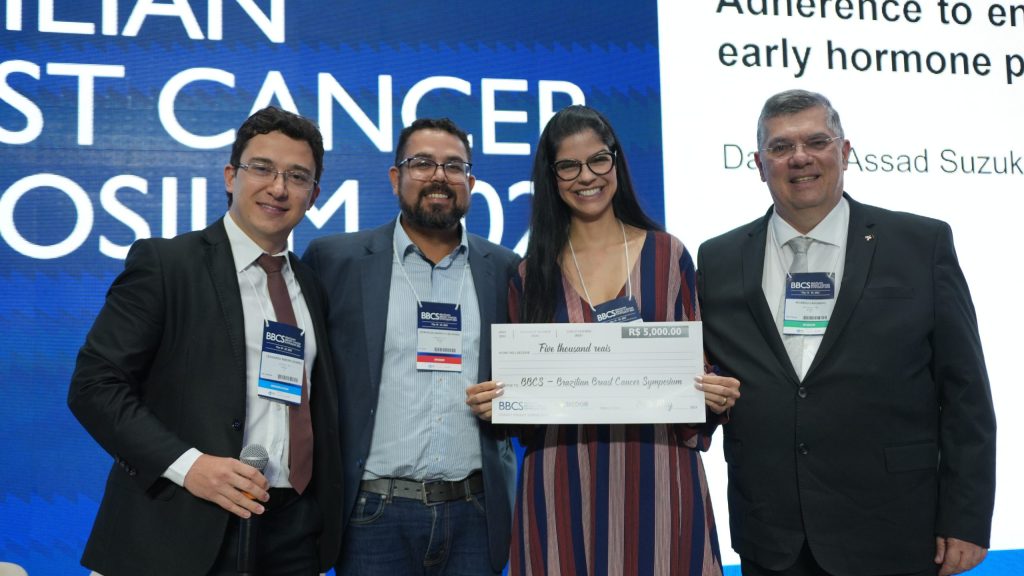
FIRST INTERIM ANALYSIS OF RADIOTHERAPY DATA AFTER 4.5 YEARS OF SENTINEL LYMPH NODE BIOPSY VERSUS NO AXILLARY SURGERY IN EARLY BREAST CANCER CLINICALLY AND ULTRASONOGRAPHICALLY NODE NEGATIVE: A PROSPECTIVE RANDOMIZED CONTROLLED TRIAL – VENUS TRIAL
Danielle Cristina Miyamoto Araújo¹, Giuliano Mendes Duarte¹, Sergio Carlos Barros Esteves¹, Rodrigo Menezes Jales¹, Eduardo Carvalho Pessoa², Idam de Oliveira Júnior³, Luis Otávio Sarian¹, VENUS Trial Group4
1Department of Gynecology and Obstetrics, Faculty of Medical Sciences, State University of Campinas (UNICAMP), Brazil.
2Department of Gynecology and Obstetrics at Universidade Estadual Paulista Júlio de Mesquita Filho (UNESP), Brazil.
3Department of Mastology and Breast Reconstruction of the Barretos Cancer Hospital, Brazil.
4VENUS TRIAL Group
Objective: VENUS (ClinicalTrials.gov – NCT05315154 and ReBEC – RBR-8g6jbf; ethics approval: CAAE:06805118.2.0000.5404) is an ongoing trial that evaluates omission of sentinel lymph node biopsy (SLNB) in early breast cancer clinically and ultrasonographically node negative. This is a partial report on the first interim radiotherapy data collected up to 4.5 years after the VENUS trial has started. The objective is to evaluate whether radiotherapy is being uniform between VENUS groups. Methodology: Prospective, multi-center, non–inferiority randomized controlled clinical trial including T1-2 N0 (clinical/ultrasound) M0 breast cancer patients randomized into: SLNB or no axillary surgery. Adjuvant radiotherapy planning was based on local protocols adopted by each study center. In the no-surgery group, axilla status was considered N0 during planning. Radiotherapy features analyzed were: planning, number and location of fields, whole-breast/boost dose, fractioning and dose distribution in axillary levels I-III. Results: Until February 2024, 322 women were randomized. Radiotherapy was performed in 221 (SLNB n=115 and no-surgery n=106). Two-D, 3D-IMRT and 3D-Conformational planning were applied for 7, 26, 173 patients, respectively, with no imbalance across study groups (p=0.23). Mean whole-breast dose was 424742.cGy in SLNB and 4269.95cGy in no-surgery (p=0.67). Mean percentage of total prescribed breast doses distribution in axillary were: Level I 5.73% SLNB vs 2.16% no-surgery (p=0.12), Level II 0.53% SLNB vs 0.07% no-surgery (p=0.86), Level III 0.96% SLNB vs 0.00% no-surgery (p=0.06). Radiotherapy fields (axilla, supraclavicular fossa, breast and internal mammary) and boost are described and were all evenly balanced across study groups. Conclusion: Breast radiotherapy has achieved an unintentional low radiation dose in the axilla of some patients, mainly at Level I. However, there was no difference between VENUS trial groups in radiotherapy parameters. So far, with more than 40% of the sample size achieved, there has been no violation of radiotherapy procedure protocol in the VENUS trial.
Keywords: Breast neoplasms, Breast cancer, Sentinel lymph node biopsy, Breast cancer treatment, Axillary surgery, Ultrasound, Radiotherapy

ADHERENCE TO ENDOCRINE ADJUVANT THERAPY IN WOMEN WITH EARLY HORMONE POSITIVE BREAST CANCER
Daniele Assad Suzuki¹, Danielle Laperche dos Santos², Anna Luiza Galvão³, Sulene Cunha Souza Oliveira4, Cristiano de Pádua Souza5, Amanda Guimarães Castro Custódio¹, Romualdo Barroso-Sousa6
¹ Hospital Sírio Libanês|Brasília|Distrito Federal|Brazil
² Hemolabor|Goiânia|Goiás|Brazil
³ UniCeub|Brasília|Distrito Federal|Brazil
4 Liga de Câncer de Natal|Natal|Rio Grande do Norte|Brazil
5 Hospital de Amor|Barretos|São Paulo|Brazil
6 Hospital Brasília, DASA Oncologia|Brasília|Distrito Federal|Brazil
Objective: This study aims to evaluate adherence to adjuvant endocrine therapy in woman with early breast cancer and explore its relationships with patients’ clinical and social characteristics and site of treatment. Methodology: Women with a past history of early-stage estrogen-receptor positive invasive carcinoma of the breast on adjuvant endocrine therapy for at least 6 months were invited to participate of this study. Adherence was assessed with questionnaire MMAS-8. Demographic and clinical information were reviewed from medical records. Data collection performed using RedCap software and statistical analyzes were performed on the software R (R Core Team (2022). Results: From June 2021 to March 2023, a total of 212 patients were recruited in 6 institutions. Median age was 56 years. 29,2% were black. 24,1% were premenopause. 38,2% had stage I disease. 65,1% received chemotherapy. 16,5% received HER2 blockade. Mean duration of endocrine therapy use was 3,7 years. 115 patients (54,2%) used aromatase inhibitors. 24 patients (11,4%) had low adherence, 76 (365) had intermediate and 111 (52,6%) had high adherence to adjuvant endocrine therapy. There is a tendence that more postmenopausal women were classified in high adherence grupo than premenopausal women (55.9% vs 42% p=0,19). There is a tendence that more woman in public service had high adherence than woman in private service (59.3% vs 50.3% p=0.07). There was no difference in adherence in relation to ethinicity, type/duration of endocrine treatment. Conclusion: This study for the first time show that high adherence to endocrine therapy only happens in 52.6% of patients, lower than reported in previous studies. This result draws attention because it can compromise survival. We will continue the recruitment of patients in the private service and in the public service to assess the rate of adherence in a larger population and the relationship with demographic characteristics.
Keywords: Hormone Therapy; Breast Cancer; Medication Adherence